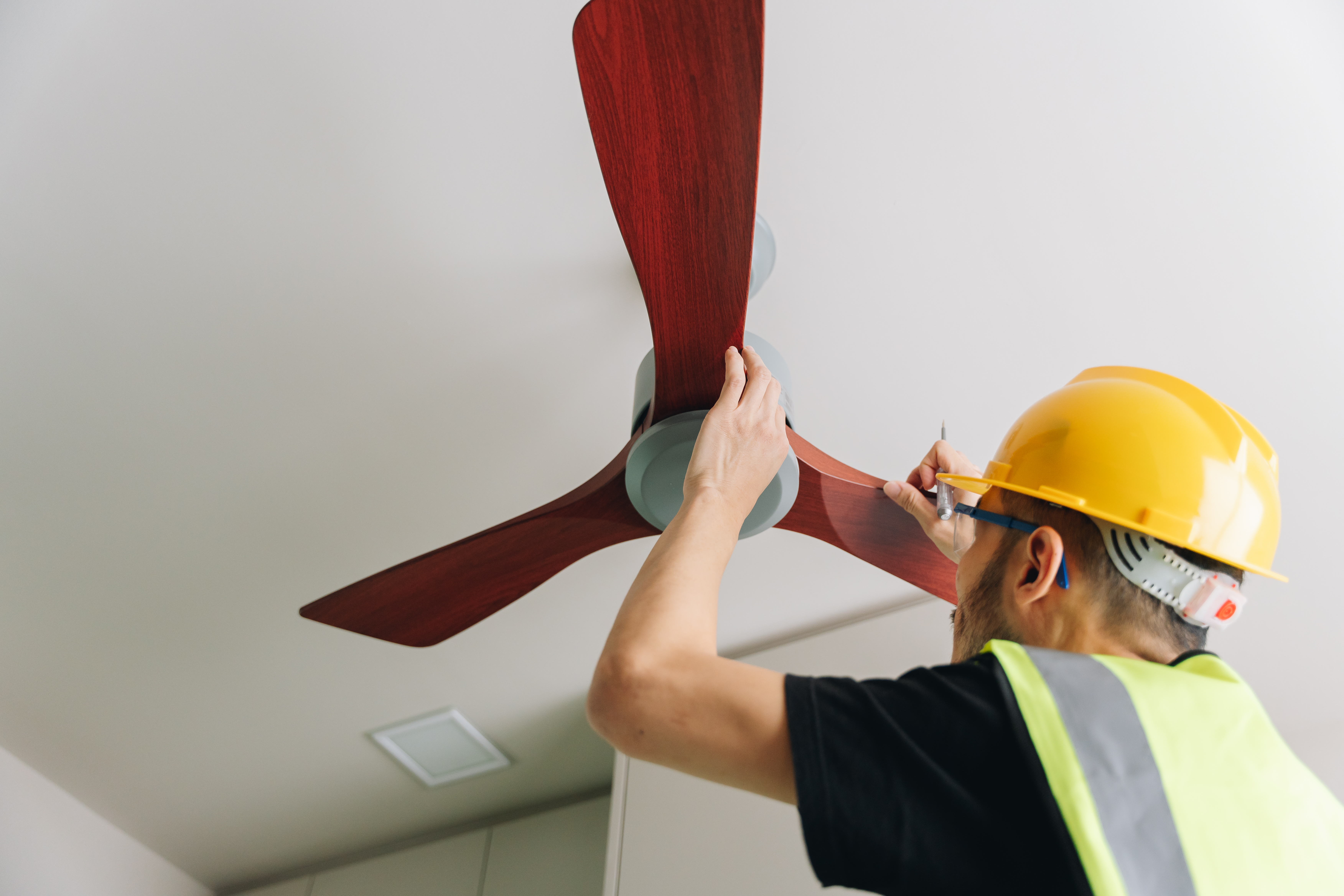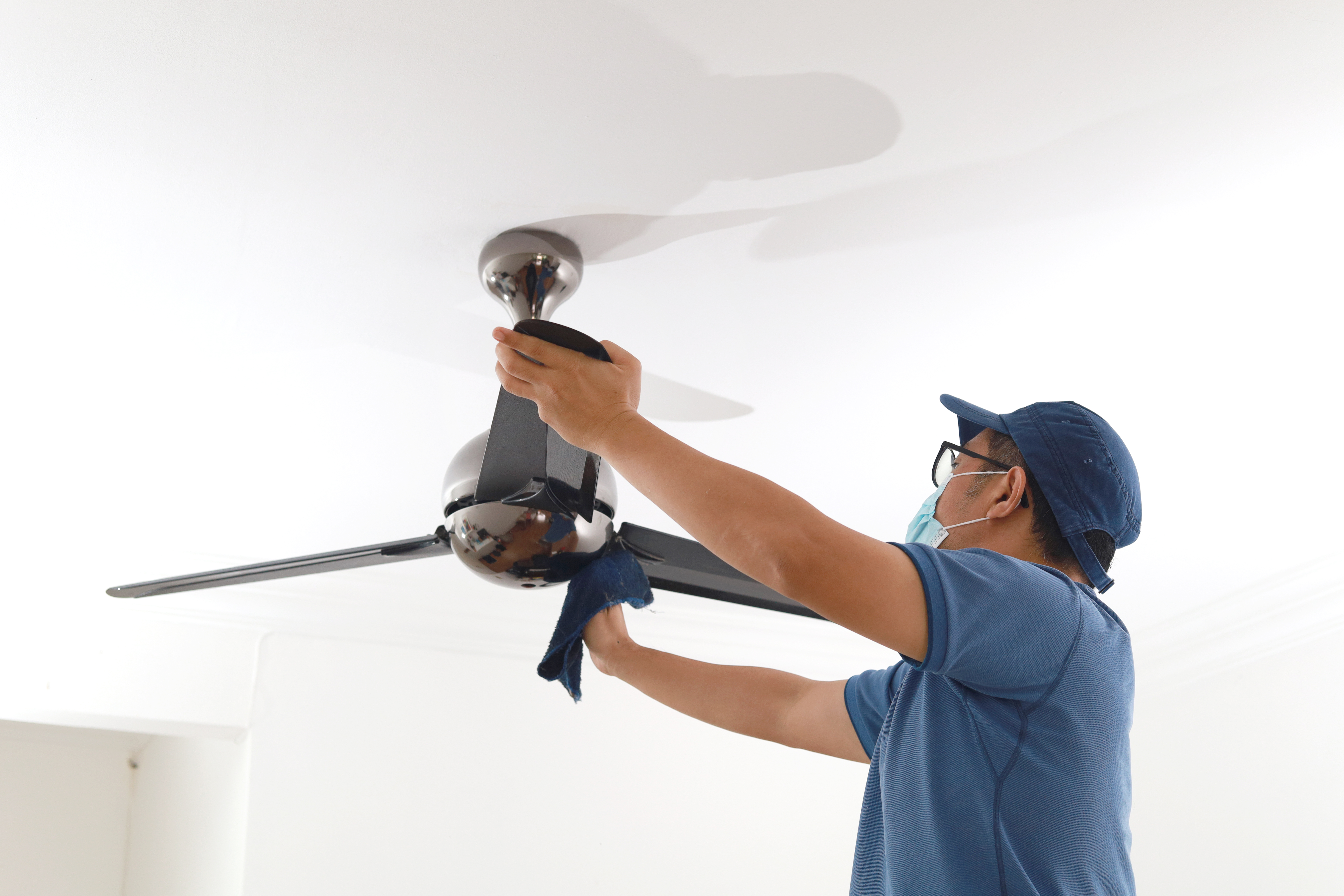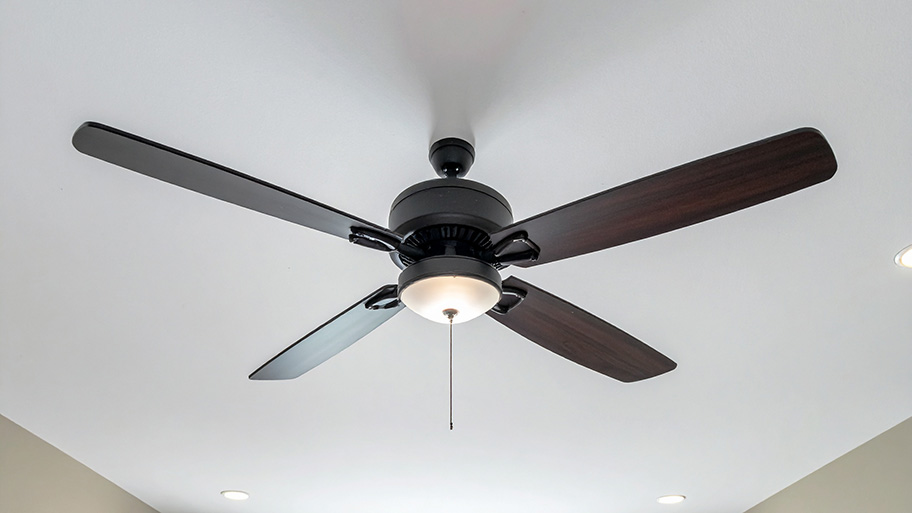
If your ceiling fan stops working due to a bad motor or broken pull chain, here’s what you can expect to pay to get it fixed.
It’s hard to stay cool, calm, and collected when your ceiling fan is wobbling


A well-installed and maintained ceiling fan should never fall off a ceiling, even at high speeds.
Call a pro immediately if your ceiling is sagging near your ceiling fan.
Wobbling and loud noises can be normal or can be a hazard, depending on the severity.
Ceiling fans are pretty simple to repair yourself, unless they involve electrical components.
It costs an average of $140 to repair a ceiling fan, or $250 to replace it.
A wobbly or wonky ceiling fan can look like a hazard, but it doesn’t always mean it’s going to fall. In fact, ceiling fans are pretty sturdy and are rarely at risk of falling off your ceiling. But that doesn’t mean there’s zero risk. If the fan was installed incorrectly or some part is damaged, there’s always a chance that your ceiling fan will fall and damage your home or, in the worst case scenario, you. Keep reading to find out when you should be wary of your ceiling fan.
While there’s no need to panic when your ceiling fan falls off the ceiling, there are some situations where a bit of fear may be warranted. Here are some signs that your ceiling fan may fall or at least require your attention immediately.

A sagging ceiling could weaken its structure, putting your ceiling fan at risk of falling. While the fan itself may not be the culprit, other causes of sagging ceilings, like a weak joint or a leak, could eventually lead to your ceiling fan falling.
A shaky or wobbling ceiling fan can be scary and is easily one of the most visual indicators that a ceiling fan may fall off the ceiling. Ceiling fans are mounted into studs in your ceiling, which keeps them steady during use, leaving you wondering why your ceiling fan wobbles.
There are many reasons why it could be wobbling, but one of the most critical ones that requires attention is if it’s a bad installation job, as this is one of the times that a wobbly ceiling fan can fall off.
A normal ceiling fan should be perfectly level, so an off-kilter fan is a sure sign that something is wrong. The culprit could be loose screws or damaged blades, either of which could lead to a blade or other part flying free from the fan and damaging your home.
Ceiling fans aren’t always whisper quiet, but you definitely shouldn’t notice clicking, rattling, or humming. And if the sounds are new, there’s probably a reason why your ceiling fan is making noise all of the sudden, like a loose screw or a wiring issue.
Clicking is a pretty common sound that a ceiling fan makes, but in some cases, it’s actually a sign that something is wrong. If your fan is clicking, look for loose or bent blades, as these could eventually fly off if not secured properly.
Rattling likely means that your fan isn’t connected properly, so the base isn’t flush with the wall and is making noises as it operates. It could also be a loose screw or bracket that’s rattling around.
Humming is one of the ceiling noises you certainly shouldn’t ignore. If your ceiling fan or the light switch is making humming sounds, there’s probably an issue with the wiring. Bad wiring could eventually melt wires and weaken the mounting bracket or ceiling box, leading your fan to fall from the ceiling.
Loose screws anywhere on your ceiling fan are a hazard, but especially those that connect your fan to the mount on your ceiling. As the fan rotates, it will continue to loosen any screws that aren’t properly in place, eventually causing damage if left untreated.
Warped blades cause an imbalance in your fan that leads to wobbling, shifting, and strain that could put your fan at risk of falling without proper care. While it’s not an emergency like some other signs on this list, like a sagging ceiling, it’s definitely something you should mitigate as soon as possible.

If the wobbling is severe or there are issues with the electrical components of your fan, it’s time to call a pro. Who to hire to repair your ceiling fan depends on the issue at hand. If it’s a problem with the wiring, you’ll need to call an electrician. But if it’s an issue with the mounting or stud, you may actually need to hire a carpenter or even a structural engineer to ensure that your ceiling is able to handle a ceiling fan.
Keep in mind that, in some cases, it’s more cost-effective simply to replace your ceiling fan yourself so you don’t have to pay for parts and labor.
It’s not hard to repair or replace a ceiling fan, as long as you know where your electrical box is and have a steady ladder. You can easily do an online search to learn how to remove a ceiling fan safely and handle it all yourself.
The best thing you can do to keep your ceiling fan from falling is to take care of it regularly. About every six months, you should take time to tackle your ceiling fan maintenance checklist. Check all the ceiling fans in your house, inspecting each element to see if it needs any attention, like cleaning the blades, tightening any loose screws, and lubricating the bearings.
It costs an average of $140 to repair a ceiling fan, with a typical range of $88 to $197. Swapping the motor is one of the more expensive repairs, costing up to $350. If it’s a bad motor, replacing your ceiling fan probably makes the most sense. But standard repairs like changing out a blade or getting a new pull chain are more affordable and worth the cost.
When considering whether or not to replace it, consider the cost of a new fan versus the cost of the repair. On average, it costs $250 to replace your ceiling fan (including the fan itself and labor), although prices can range up to $500 if it’s more complicated or heavy.
From average costs to expert advice, get all the answers you need to get your job done.

If your ceiling fan stops working due to a bad motor or broken pull chain, here’s what you can expect to pay to get it fixed.

Discover the cost to install a ceiling fan, including labor, materials, and tips to save. Learn what impacts your price and how to budget for your project.

A 3-blade vs. 5-blade ceiling fan varies in design and function. Learn the differences between them so you know which is best for your space.

Removing a ceiling fan is an easy task that any handy DIYer can tackle. Follow the five steps in this guide to learn how to remove a ceiling fan.

With the right size, ceiling fans are an energy-efficient way to cool a room. Use this ceiling fan size guide to find the perfect model for your space.

Ceiling fans need the help of lubrication to run smoothly and quietly. Learn how to oil a ceiling fan without taking it down in a few simple steps.